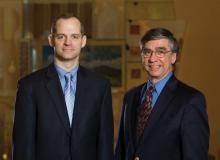The Problem
A 76-year-old female with a history of hypertension, coronary artery disease, and degenerative joint disease of the spine presents with her husband because of a several-month history of depression. She denies suicidal ideation but admits to a seasonal component to her mood changes. Her score on the 9-item Patient Health Questionnaire is 10. Over the next several months, you try several different antidepressants that seem to help to a minor degree, but they cannot be continued because of intolerable side effects. She tells you that she is a "tough Norwegian" and will "grin and bear it." You recall your colleague telling you about the "blue light" that another colleague uses for the nursing home patients. You are not aware of the evidence for this therapy and investigate.
The Question
Is light therapy effective for the alleviation of depression symptoms in elderly patients?
The Search
You open PubMed (www.pubmed.gov), enter "light therapy," and limit to "Randomized Controlled Trial."
The Evidence
"Bright light treatment in elderly patients with nonseasonal major depressive disorder: a randomized placebo-controlled trial" (Arch. Gen. Psychiatry 2011;68:61-70).
• Study Design and Setting: This double-blind, placebo-controlled, randomized clinical trial was conducted in outpatient clinics and general practitioners’ offices in the Amsterdam region.
• Participants: Potential subjects had to be at least 60 years old and were selected using the 15-item version of the Geriatric Depression Scale. Depression was diagnosed using the Structured Clinical Interview for DSM-IV Axis I disorders. Severity was rated with the structured interview guide for the Hamilton Rating Scale for Depression (HAM-D)–seasonal affective disorder version.
• Intervention: Participants were randomized to receive one of two light box conditions at home. In one, a bright-light therapy (BLT) group received treatment involving a mist-blue filter with high-throughput pale blue light (7500 lux). In the second, a control group received an intervention involving a blood-red filter with low-throughput red light (50 lux) that is considered to be biologically inactive. Exposure was 60 minutes daily in the early morning for 3 weeks. Light boxes were by Philips Bright Light Energy HF 3304.
• Outcomes: Assessments were performed before the start of light treatment (baseline, or T0), immediately upon completion of the 3-week treatment interval (T1), and 3 weeks after the end of the treatment (T2). The primary outcome was determined to be the change in HAM-D score at T1 relative to T0. Secondary efficacy outcome measures were change in HAM-D score at T2 relative to T0 to determine whether immediate responses would last after treatment discontinuation, and the dichotomized treatment response for T1 relative to T0 and T2 relative to T0 (with responders vs. nonresponders, defined according to whether the HAM-D score decreased by at least 50%). Cortisol and melatonin concentrations were also determined. Actigraphy measurement and self-reported get-up times were also obtained.
• Results: In all, 89 participants were randomized (42 BLT, 47 control). Data were available for analysis on 40 people in the BLT group and 44 in the control group. The groups were not balanced at baseline, so baseline scores were used as covariates in all analyses. Significantly more T0 to T1 improvement in HAM-D scores were observed in patients in the BLT group (43%; 8.5 points; 95% confidence interval, 6.8-10.3) than in the control group (36%; 5.8 points; 95% CI, 4.0-7.6; P = .03). Significantly more T0 to T2 improvement in HAM-D scores were observed in the BLT group (54%; 10.0 points; 95% CI, 8.6-12.0) than in the control group (33%; 5.4 points; 95% CI, 3.9-6.9; P = .001). At T1, no significant differences were observed in the percentage of patients who were responders (20 patients [50%] in the BLT group vs. 18 patients [41%] in the control group; P = .20). At T2, 23 patients (58%)in the BLT group were responders, compared with 15 (34%) in the control group (P = .05). Use of antidepressants did not affect treatment response. At T1 relative to T0, get-up time in the BLT group advanced by 7% (P = .001), sleep efficiency increased by 2% (P = .01), and the steepness of the rise in evening melatonin levels increased by 81% (P = .03) compared with responses in the control group. The evening salivary cortisol level decreased by 34% in the BLT group, compared with an increase of 7% in the placebo group (P = .02).
Our Critique
This was a well-designed and -conducted, randomized, controlled clinical trial. Investigators blinded participants and instructors to the study hypothesis. Interviews were conducted by clinicians who were blinded to treatment assignment. The findings clearly suggest that BLT alleviates depression in elderly patients. BLT decreases total sleep duration by advancing get-up time after final awakening while increasing sleep efficiency. Effect sizes were comparable to antidepressants without any adverse effects.


